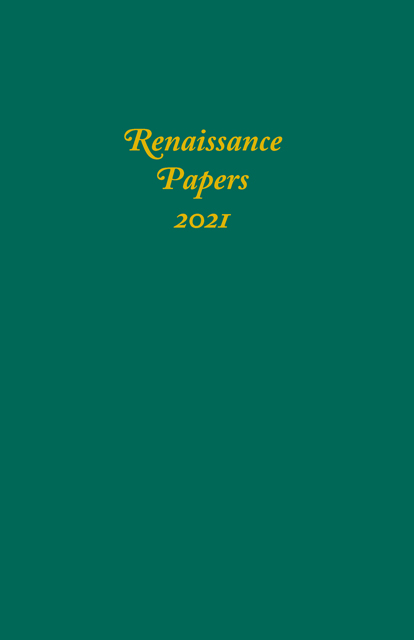Book contents
- Frontmatter
- Contents
- Dedication
- “Strange Serious Wantoning”: Early Modern Chess Manuals and the Ethics of Virtuous Subterfuge
- “Both Use and Art”: Motifs and Method in Astrophil and Stella
- Embodied Love(rs): Injury and Comedy in Mary Wroth’s Urania
- Edmund Spenser’s Automaton Alchemy: The Case of False Florimell
- Who Edited the 1571 Mirror for Magistrates?
- Statues Living and Conscious: Hermetic Statue-Magic in The Winter’s Tale
- Transmutation and Refinement: The Metaphysics of Conversion and Alchemy in Renaissance Spain
- The Twelve Inka and the Twelve Caesars: Reflections on an Early Modern Visual Theme in the Art of Colonial Peru
- Linguistics and Epistemology in Thomas Harriot’s North Atlantic World
- Assembling the King’s Body: Examining Holbein’s Portrait Techniques and the Fashioning of Henry VIII’s Image in the English Renaissance
- Molière’s L’École des Femmes between Shame and Guilt
Assembling the King’s Body: Examining Holbein’s Portrait Techniques and the Fashioning of Henry VIII’s Image in the English Renaissance
Published online by Cambridge University Press: 17 December 2022
- Frontmatter
- Contents
- Dedication
- “Strange Serious Wantoning”: Early Modern Chess Manuals and the Ethics of Virtuous Subterfuge
- “Both Use and Art”: Motifs and Method in Astrophil and Stella
- Embodied Love(rs): Injury and Comedy in Mary Wroth’s Urania
- Edmund Spenser’s Automaton Alchemy: The Case of False Florimell
- Who Edited the 1571 Mirror for Magistrates?
- Statues Living and Conscious: Hermetic Statue-Magic in The Winter’s Tale
- Transmutation and Refinement: The Metaphysics of Conversion and Alchemy in Renaissance Spain
- The Twelve Inka and the Twelve Caesars: Reflections on an Early Modern Visual Theme in the Art of Colonial Peru
- Linguistics and Epistemology in Thomas Harriot’s North Atlantic World
- Assembling the King’s Body: Examining Holbein’s Portrait Techniques and the Fashioning of Henry VIII’s Image in the English Renaissance
- Molière’s L’École des Femmes between Shame and Guilt
Summary
The most famous portrait of Henry VIII depicts the king in a full-length, frontal pose. Authority comes from his bodily presence, overwhelming the viewer, and promoting Henry Tudor as in command of his mind and body (see fig. 1). While the portrait is famous, the composition was originally part of Hans Holbein the Younger’s Whitehall Palace dynastic mural that was lost in a 1689 fire, but Holbein’s cartoon, a large preparatory drawing, has survived (fig. 2). Holbein’s cartoon differs from his existing English court drawings because it depicts the king’s full body. Instead, most of Holbein’s drawings focus on the upper body, highlighting the face as crucial to the sitter’s likeness while the body becomes secondary. However, Holbein’s drawing of Henry VIII denotes equal attention to the king’s face and body. His clothing is elaborate, his pose dynamic, and his body is constructed in a way that nothing seems to be hidden from the viewer.
Holbein’s choice to render Henry’s full-length body is striking because of the reality of the king’s obese, disabled body. Henry’s legend—both contemporarily and historically—is rooted in the changes his body and mind underwent throughout his reign where he becomes, according to historians Robert Bucholz and Newton Key a “vain and corpulent lecher, eating, whoring, and executing his way through marriage after marriage, ministry after ministry.” This image of Henry is both truthful and a “distortion.” Historical memory has reduced Henry to a man of shortcomings, but could this distortion have grown out of his own representation? As Jane Roberts argues “it is no exaggeration to state that our vision of the court of Henry VIII is dependent upon Holbein’s images,” connecting Holbein’s artistic practice to Henry’s constructed image. Advancing the interdisciplinary interest in tying Henry’s physical health to his authoritative image, I argue that Holbein’s portrait drawings of English courtiers replace the body of Henry VIII. By emphasizing facial details, Holbein’s drawings of the Tudor court deflect attention from and render the body as secondary in his portrait production. Holbein’s technique of manipulating his sitter’s features during the artwork’s lifespan, from drawing to transfer to painting, works in tandem with the changes Henry’s body underwent throughout his reign.
- Type
- Chapter
- Information
- Renaissance Papers 2021 , pp. 123 - 144Publisher: Boydell & BrewerPrint publication year: 2022



